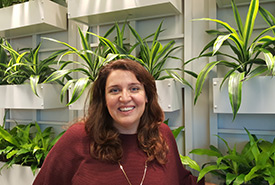Women in conservation: Catherine Ennis

Catherine Ennis (Photo by NCC)
In honour of International Women’s Day (March 8), we’re celebrating six female staff members at the Nature Conservancy of Canada (NCC) who are working to create a stronger future for Canada’s landscapes.
Growing up in the coastal town of Greystones, along Ireland’s east coast, Catherine Ennis took her childhood appreciation for nature and integrated it into her studies and now her career at NCC.
Catherine is the director, business applications at NCC. She studied environmental science at Trinity College, the University of Dublin, and continued her studies, graduating with a master’s in geographic information systems from the University of Edinburgh in Scotland. She is currently studying strategic management of enterprise IT at night at the University of Toronto.
Read my interview with Catherine below:
Raechel Bonomo (RB): How has nature impacted your life?
Catherine Ennis (CE): Growing up, I was very interested in nature and associated subjects and hobbies. I chose my career based on my keen interest in nature and geography, and I consider it a great privilege to combine my interests and career at NCC.
RB: Why is working at NCC important to you?
CE: I’m fortunate that I’ve found the perfect combination of my two fields of interest and study working at NCC, namely technology and environment. I believe in the work of NCC, which seeks to protect nature. I believe that good technology and systems are critical to this work. Being part of the IT business applications team at NCC means I can focus on the continuous improvement of the underlying information systems to support our conservation efforts.
RB: How does technology make an impact on land conservation in Canada?
CE: Technological tools and innovation are helping us gather, store and analyze conservation information in time and space at scales we have never been able to do before. It’s also helping us to quantify the value of our natural environment against increasing rate of habitat loss, species extinction and climate change. As conservation challenges increase, it can be hard to keep up, but technology is helping us do so. For example, we now have the ability to remotely monitor ecosystems in real time. Technology is also allowing us to share more meaningful information with a wider audience, educating more people on the importance of conservation and sustainability, collaborating on conservation efforts globally and tracking our progress so we can do better.
RB: What career advice would you give your younger self, if you could?
CE: Seek to inform yourself on current practices and innovation. Work hard! Stay current! Give 100 per cent! Above all, collaborate with colleagues and peers, and in doing so, learn from them.


